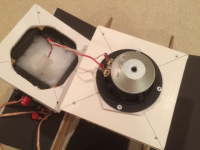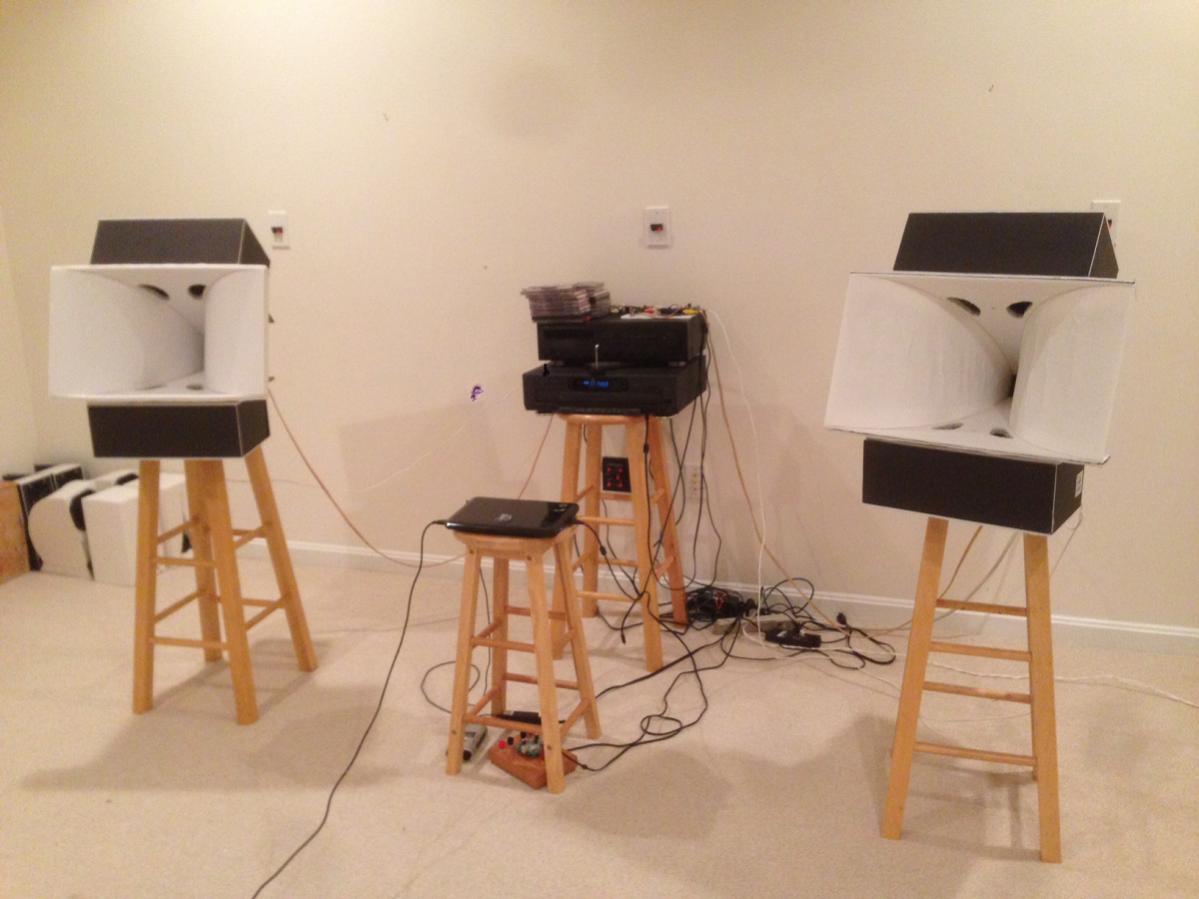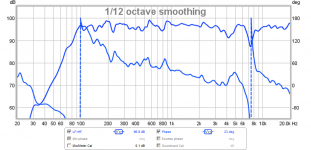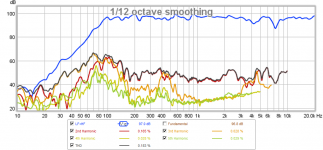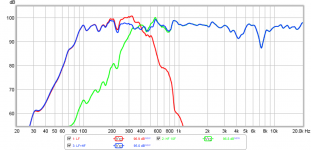I use SPAX (drywall) construction screws for all my projects. The are self drilling and grip everything. Although I predrill a small hole to keep plywood from splitting.
Those are the right drivers. You need terminals plugs/cups/posts whatever you like to use to connect the driver to your amp. I use the cheap 5-way binding banana posts from PE.
For a sub you are into 3-way, you can get a plate amp with its own low pass XO and set it for 100Hz. Or get two 2x4 miniDSP's and control the sub that way.
Those are the right drivers. You need terminals plugs/cups/posts whatever you like to use to connect the driver to your amp. I use the cheap 5-way binding banana posts from PE.
For a sub you are into 3-way, you can get a plate amp with its own low pass XO and set it for 100Hz. Or get two 2x4 miniDSP's and control the sub that way.
Trynergy Returns with Harsch XO
I finally took the Trynergy out of storage and set it up with the Harsch XO for quasi-transient perfect response from a two-way. I forgot how darn loud these things are. Wow. My ears are ringing after a few sweeps.
The Harsch XO was implemented with a -24dB/oct BW HPF at 400Hz and -6dB/oct (electrical) BW at 700Hz for an acoustic 450Hz XO with a 2nd order slope on the 3FE22.
Bass from quad woofers falls off below 100Hz but a drum solo sounds so convincing with great visceral impact. It sounds like a live drum kit from a 3in driver assisted by four 6.5 in woofers. The dynamic snap is so intense, lots of headroom.
Anyhow, here is a sound clip of a Harsch XO Trynergy with a drum solo. Sounds wonderful. Now I remember why I love these speakers.
Change file to .mp3 to listen. It sounds even better in 96kHz FLAC, included is a much shorter clip in FLAC format.
I finally took the Trynergy out of storage and set it up with the Harsch XO for quasi-transient perfect response from a two-way. I forgot how darn loud these things are. Wow. My ears are ringing after a few sweeps.
The Harsch XO was implemented with a -24dB/oct BW HPF at 400Hz and -6dB/oct (electrical) BW at 700Hz for an acoustic 450Hz XO with a 2nd order slope on the 3FE22.
Bass from quad woofers falls off below 100Hz but a drum solo sounds so convincing with great visceral impact. It sounds like a live drum kit from a 3in driver assisted by four 6.5 in woofers. The dynamic snap is so intense, lots of headroom.
Anyhow, here is a sound clip of a Harsch XO Trynergy with a drum solo. Sounds wonderful. Now I remember why I love these speakers.
Change file to .mp3 to listen. It sounds even better in 96kHz FLAC, included is a much shorter clip in FLAC format.
Attachments
Last edited:
that clip would probably be pretty good on a K12 or X15 size Karlson with either good (~98-100dB) coax/woofer or K-tube. X-15 used the K-tube internally mounted.
Trynergy with 10F/8424 and Harsch XO
I swapped out the 3FE22 with the 10F/8424 and no surprise, it sounds better. More clear, more crisp, greater dynamic impact. Here is recording of the same clip.
Also added a vocal to show clarity.
The speaker is about 96dB sensitive after EQ cutting the full range driver to match the woofer.
I swapped out the 3FE22 with the 10F/8424 and no surprise, it sounds better. More clear, more crisp, greater dynamic impact. Here is recording of the same clip.
Also added a vocal to show clarity.
The speaker is about 96dB sensitive after EQ cutting the full range driver to match the woofer.
Attachments
Last edited:
Oh, didn't know. So often you seem to only build one. Was the vocal clip done with both and then left channel only converted to mono? It sounds really good.
Vocal was done with one speaker and recorded in mono. Yes, the sound quality of the vocals with this is one of the best. Piano sounds really good too - the attack can clearly be heard.
Yes, often I don't get around to the stereo pair. I am waiting for time to make the PMC inspired TL monitor right now. I have other audio projects that are going on so sometimes don't have time to make the second.
Yes, often I don't get around to the stereo pair. I am waiting for time to make the PMC inspired TL monitor right now. I have other audio projects that are going on so sometimes don't have time to make the second.
How difficult is programming the minidsp? I would like to build these but I'm concerns my measurements might be poor effecting my dsp settings.
miniDSP programming is easy. I can guide you through it once you build it.
Take measurements at 0.5m to avoid floor bounce (with speakers on at least 30in tall stands).
1. First take raw measurements of each driver running full range. If you want, also take measurement of both drivers driven in parallel from same wires. In all cases, don't touch position of mics or speakers in betweeen sweeps. Use this FRD data in software like PCD to derive the acoustic offset (native delay).
2. Use EQ to flatten responses as much as possible by peak cuts, or shelf filters. I typically use 4 to 5 PEQ's per driver. The woofer is pretty easy, mostly flat but needs a peak cut to reduce the bandpass injection peak around 630Hz. I also do a wide deep cut around 5k to kill the breakup peaks even though I low pass it with BW4 at 400Hz.
3. The full range driver will typically require a either a high shelf boost of 10dB at 3.5kHz Q=0.8 or a low shelf cut of -10dB at 3.5kHz Q=0.8. Then there are 2 or 3 peaks that sometimes need some trimming. Typically -3dB Q=2.5 or so. The mid tweet also needs to be padded (gain cut) to match woofers. Typically, the horn gives +10 to +12dB boost so an 87dB driver becomes 99dB sensitive. For woofers used here, they are about 88dB ea or 94dB in series/parallel and then they get maybe 3dB boost for being in the horn and directional so about 97dB. So about -2dB to -3dB cut on mid tweet will match (depending on sensitivity).
4. Avoid using peak boost if at all possible as that increases HD. However, for the full range driver above 8kHz, it's OK to boost by 3dB to 5dB as the excursion there is small.
5. Set the XO as follows for a basic easy to do XO but it is not transient perfect. Use LR4 symmetric at circa 400Hz to 500Hz. Adjust time delay on mid/tweet to get good alignment. Check by inverting polarity on mid/tweet and adjusting the delay in little steps until you get the deepest null. Then flip polarity back.
6. Set the XO for advanced Harsch quasi transient by setting woofer as -14dB/oct BW LPF at 400Hz, set mid tweet as -6dB/oct BW HPF arounf 400Hz to 700Hz (depends on driver and rear chamber). Acoustically, the mid tweet will be 2nd order which is what you want for Harsch XO.
7. Set delay on mid tweet to equal half the time period of the acoustic crossover frequency, assuming woofer and tweeters are already time aligned with proper acoustic offsets. Depending on where bass injection ports are located - it may be from 0.4 to 0.6ms. Mine was best at 0.54ms delay.
Look in Harsch XO thread for more tips. When you get it right, drums sound very crisp and piano is super clear on key strikes.
Take measurements at 0.5m to avoid floor bounce (with speakers on at least 30in tall stands).
1. First take raw measurements of each driver running full range. If you want, also take measurement of both drivers driven in parallel from same wires. In all cases, don't touch position of mics or speakers in betweeen sweeps. Use this FRD data in software like PCD to derive the acoustic offset (native delay).
2. Use EQ to flatten responses as much as possible by peak cuts, or shelf filters. I typically use 4 to 5 PEQ's per driver. The woofer is pretty easy, mostly flat but needs a peak cut to reduce the bandpass injection peak around 630Hz. I also do a wide deep cut around 5k to kill the breakup peaks even though I low pass it with BW4 at 400Hz.
3. The full range driver will typically require a either a high shelf boost of 10dB at 3.5kHz Q=0.8 or a low shelf cut of -10dB at 3.5kHz Q=0.8. Then there are 2 or 3 peaks that sometimes need some trimming. Typically -3dB Q=2.5 or so. The mid tweet also needs to be padded (gain cut) to match woofers. Typically, the horn gives +10 to +12dB boost so an 87dB driver becomes 99dB sensitive. For woofers used here, they are about 88dB ea or 94dB in series/parallel and then they get maybe 3dB boost for being in the horn and directional so about 97dB. So about -2dB to -3dB cut on mid tweet will match (depending on sensitivity).
4. Avoid using peak boost if at all possible as that increases HD. However, for the full range driver above 8kHz, it's OK to boost by 3dB to 5dB as the excursion there is small.
5. Set the XO as follows for a basic easy to do XO but it is not transient perfect. Use LR4 symmetric at circa 400Hz to 500Hz. Adjust time delay on mid/tweet to get good alignment. Check by inverting polarity on mid/tweet and adjusting the delay in little steps until you get the deepest null. Then flip polarity back.
6. Set the XO for advanced Harsch quasi transient by setting woofer as -14dB/oct BW LPF at 400Hz, set mid tweet as -6dB/oct BW HPF arounf 400Hz to 700Hz (depends on driver and rear chamber). Acoustically, the mid tweet will be 2nd order which is what you want for Harsch XO.
7. Set delay on mid tweet to equal half the time period of the acoustic crossover frequency, assuming woofer and tweeters are already time aligned with proper acoustic offsets. Depending on where bass injection ports are located - it may be from 0.4 to 0.6ms. Mine was best at 0.54ms delay.
Look in Harsch XO thread for more tips. When you get it right, drums sound very crisp and piano is super clear on key strikes.
Last edited:
Hey Johnsey.
It's relative. Compared to the risk of getting a passive xo wrong it's about 50 to 1.
By that I mean once you work out how to plug the MiniDSP up the gui is like using a phone and a basic understanding of filters will get you surprisingly good results.
That's when the aha moment happens and you realize that you can sit in front of your system with a laptop and try almost any new xo and eq settings you like as you listen.
So you can essentially get 80% or the way to awesome just by following others. Using a umik is icing on the cake. Because you can save every change and learns without the continued financial investment of passive.
As a side note. And the only one I really came up against, beware the turn on thump as the board powers up. I have blown an Alpair 7.3 voice coil to smoke so I think anybody should plan to have a specific switch on sequence or a delayed (5 sec) remote start for your amps after the MiniDSP.
Hope that answered your question.
Dean
It's relative. Compared to the risk of getting a passive xo wrong it's about 50 to 1.
By that I mean once you work out how to plug the MiniDSP up the gui is like using a phone and a basic understanding of filters will get you surprisingly good results.
That's when the aha moment happens and you realize that you can sit in front of your system with a laptop and try almost any new xo and eq settings you like as you listen.
So you can essentially get 80% or the way to awesome just by following others. Using a umik is icing on the cake. Because you can save every change and learns without the continued financial investment of passive.
As a side note. And the only one I really came up against, beware the turn on thump as the board powers up. I have blown an Alpair 7.3 voice coil to smoke so I think anybody should plan to have a specific switch on sequence or a delayed (5 sec) remote start for your amps after the MiniDSP.
Hope that answered your question.
Dean
Looks like we answered both ends of the question there xrk. 🙂
Actually while we are at it, how do you deal with the dreaded turn on thump x?
Actually while we are at it, how do you deal with the dreaded turn on thump x?
That strange the thump is not that bad for me. I use TPA3116 amps and TDA7298 amps and they also have self thumps that are stronger. But I prevent it by using the minidsp volume pot. Turn it down before turning minidsp on or off or plugging in RCA's. The pot is. $2.50 option and actually is used as a voltage divider to generate a 0-5v signal that the minidsp reads to set volume via dsp. So you can even use a remote computer generated signal to control volume of your minidsp.
A7.3 have voice coil motion arrestors to prevent mechanical damage. You must have had a pretty big amp to smoke the coil thermally.
A7.3 have voice coil motion arrestors to prevent mechanical damage. You must have had a pretty big amp to smoke the coil thermally.
I really like how the Trynergy sounds with the 10F/8424.
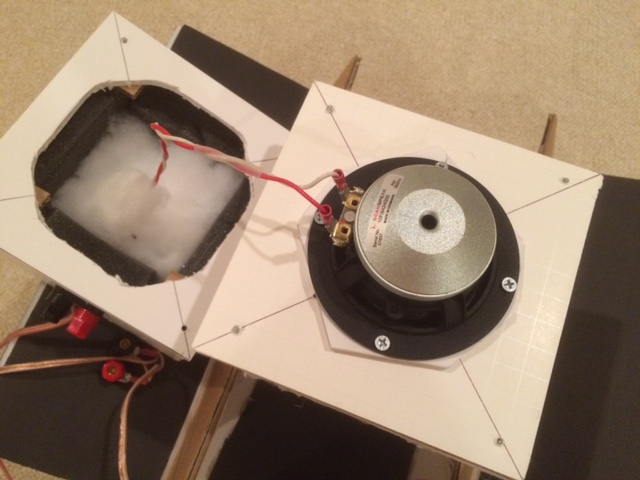
Is this not a mid speaker? do go not higher then 10 Khz.
I have thinking about the phillips drivers for the bas part of the horn, for this I have room for one, eacht side, but do i can use that? because now I do use just one port eacht side and not four.
How to change that in akabak to see what happens because I presume U use there also four woofers..
regards
The 10F/8424 may be called a mid by ScanSpeak but it is definitely full range by all accounts and measures. In an open face speaker it goes to 18kHz. As a horn driver in tractrix it hits a solid 20kHz probably due to higher efficiency. Sparkling detail - listen to the sound clips posted above and see if it sounds lacking in treble department.
For two woofers go in akabak script and look for woofer section. There will be four driver definitions and four front chambers and four injection ducts. They all go to the same point in horn. So put an "OFF" switch above each of the two drivers and their front chamber and injection duct. Make sure you re wire the nodes to how you hook it up parallel or series.
For two woofers go in akabak script and look for woofer section. There will be four driver definitions and four front chambers and four injection ducts. They all go to the same point in horn. So put an "OFF" switch above each of the two drivers and their front chamber and injection duct. Make sure you re wire the nodes to how you hook it up parallel or series.
Hi
I did find a script of you with 12 inch woofers of eminence this scrip has just two woofers so I can change that for ease.
I get a little familiair with akabak but still it is difficult.
I have found some mids, from visaton and 11F-M van seas, but these need re surrounding.
I did find a script of you with 12 inch woofers of eminence this scrip has just two woofers so I can change that for ease.
I get a little familiair with akabak but still it is difficult.
I have found some mids, from visaton and 11F-M van seas, but these need re surrounding.
10F/8424 Trynergy Measurements
Here are the measurements for the 10F in the Trynergy at 0.5m. There are a couple of sharp dips at 4k and 7.5k that are due to some rough edges I have at the throat. Will need to work on them but sharp dips are not quite that noticeable. This is at 1.64v into the 8ohm driver or about 0.34 watts and I am getting around 96 to 98dB at 0.5m.
Here is the acoustic XO plot:
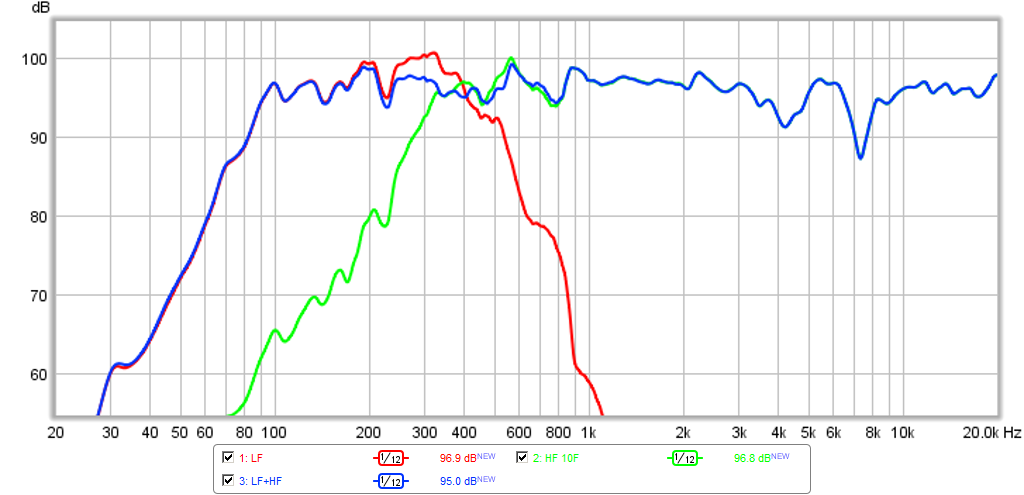
Here is the Phase:
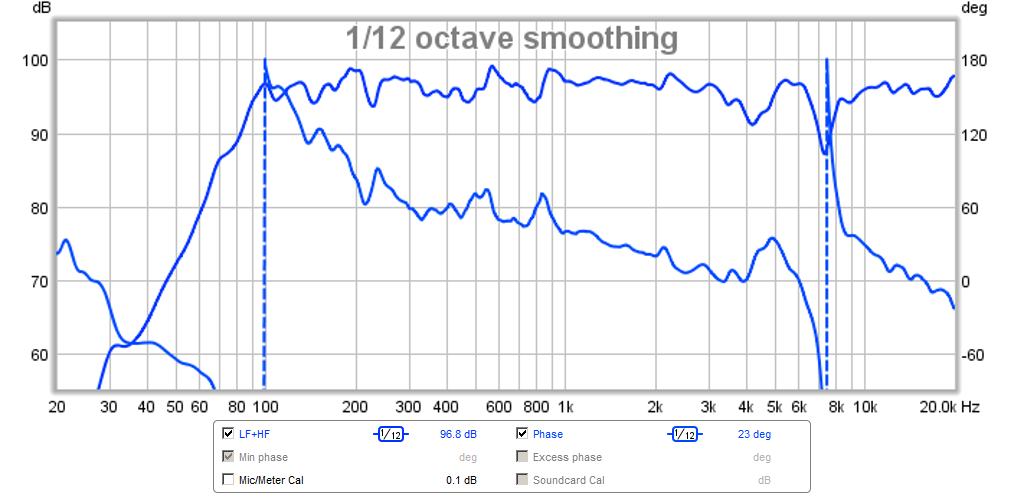
Here is the Harmonic Distortion, note that the distortion is predominantly 2nd order and 3rd order and higher is vanishingly small. Cursor is at 1kHz:

Here is Impulse Response and Step Response - there is some ringing due to the throat discontinuity artifact, and the SR does not go far since this is a 100Hz bottom end only:
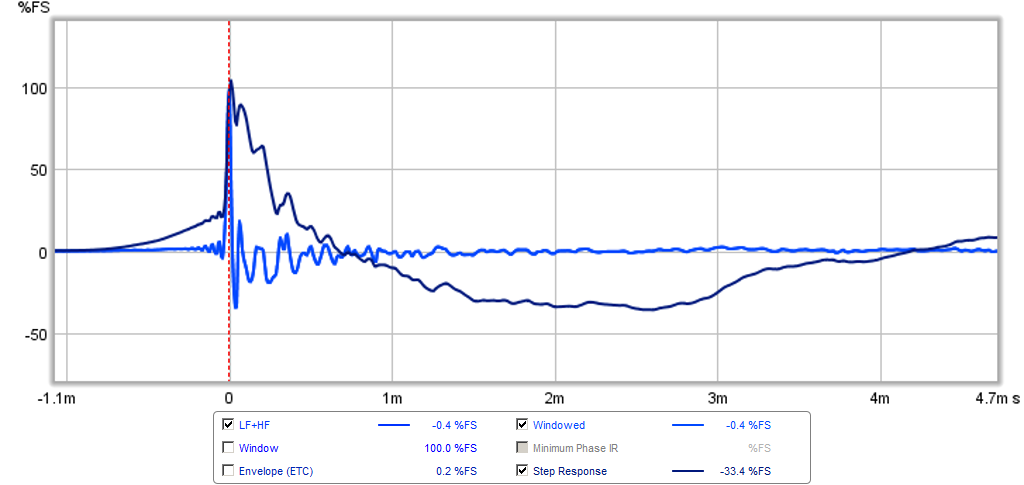
Here is the RTA looking at the HD with a 1kHz 1.64 volt excitation, I don't think I have ever seen a speaker RTA plot that looks this clean - mostly 2nd harmonic and non-existent higher orders. Some folks over in Multi-Way Forum were in disbelief that the 5MR450NDY in a tractrix had such low HD, but it was not even as low as this. This is probably the main reason why this speaker sounds so good on vocals. It is about as pure of a sound as you can get. The fundamental is about 98.6dB with a little over 300 milliwatts power driving it. The cone can't be moving much (sims predict in the tens of micro-meters). that's 0.19% THD at equivalent 92.6dB at 1m!
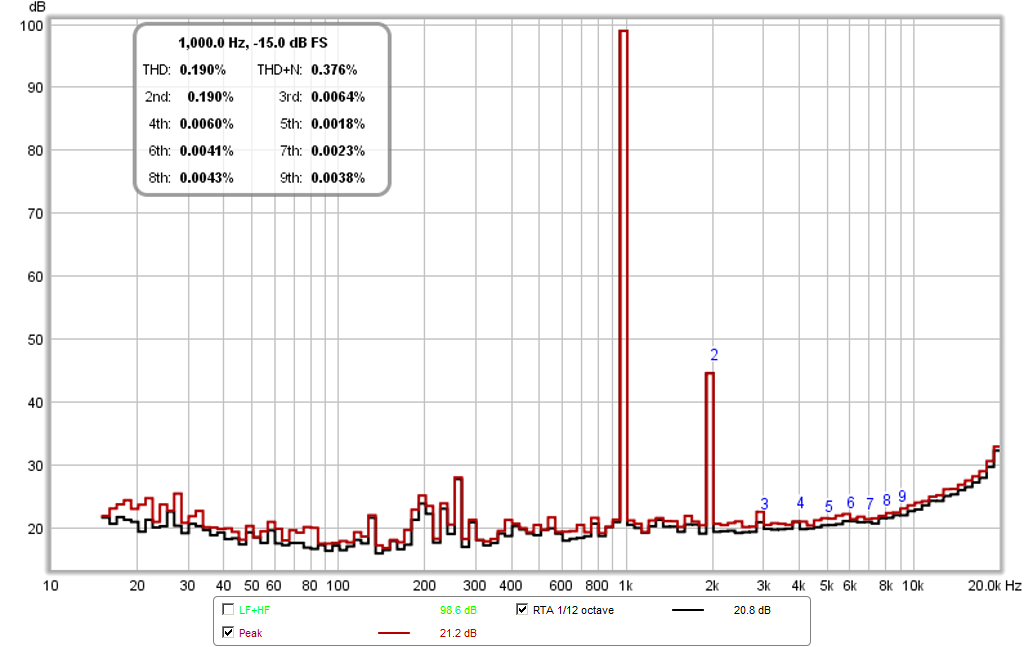
Here are the measurements for the 10F in the Trynergy at 0.5m. There are a couple of sharp dips at 4k and 7.5k that are due to some rough edges I have at the throat. Will need to work on them but sharp dips are not quite that noticeable. This is at 1.64v into the 8ohm driver or about 0.34 watts and I am getting around 96 to 98dB at 0.5m.
Here is the acoustic XO plot:

Here is the Phase:

Here is the Harmonic Distortion, note that the distortion is predominantly 2nd order and 3rd order and higher is vanishingly small. Cursor is at 1kHz:

Here is Impulse Response and Step Response - there is some ringing due to the throat discontinuity artifact, and the SR does not go far since this is a 100Hz bottom end only:

Here is the RTA looking at the HD with a 1kHz 1.64 volt excitation, I don't think I have ever seen a speaker RTA plot that looks this clean - mostly 2nd harmonic and non-existent higher orders. Some folks over in Multi-Way Forum were in disbelief that the 5MR450NDY in a tractrix had such low HD, but it was not even as low as this. This is probably the main reason why this speaker sounds so good on vocals. It is about as pure of a sound as you can get. The fundamental is about 98.6dB with a little over 300 milliwatts power driving it. The cone can't be moving much (sims predict in the tens of micro-meters). that's 0.19% THD at equivalent 92.6dB at 1m!

Attachments
Last edited:
kees52,
I haven't heard these Faitals live but feel in time got to have a pair because they looks as high value, suggestion is because if you have to repair old drivers surrounds cost for these Faitals is hard to beat, also their sensitivity is advertised as 91dB. Lowest cost seems here Faital Pro :: Faital Pro 6FE100 6" Speaker Driver 100 W 8 Ohm 23.21 but this one also okay Faital Pro 6FE100 - supersonic.
I haven't heard these Faitals live but feel in time got to have a pair because they looks as high value, suggestion is because if you have to repair old drivers surrounds cost for these Faitals is hard to beat, also their sensitivity is advertised as 91dB. Lowest cost seems here Faital Pro :: Faital Pro 6FE100 6" Speaker Driver 100 W 8 Ohm 23.21 but this one also okay Faital Pro 6FE100 - supersonic.
Attachments
Thanks for the tip Byrtt. I just saw a post by Adason where he is using the 6FE200 (95dB) as a mid-bass and loves it. Looks like a very high value driver too. $44 from PE.
http://www.parts-express.com/pedocs/specs/294-1152-faitalpro-6fe200-8-specifications.pdf
It may be able to handle the trynergy mid bass duties down to 140Hz in a sealed so not as deep as the 6FE100.
http://www.parts-express.com/pedocs/specs/294-1152-faitalpro-6fe200-8-specifications.pdf
It may be able to handle the trynergy mid bass duties down to 140Hz in a sealed so not as deep as the 6FE100.
- Home
- Loudspeakers
- Multi-Way
- Presenting the Trynergy - a full range tractrix synergy.
